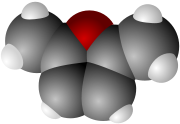- 2,5-Dimethylfuran
-
2,5-Dimethylfuran 
 2,5-Dimethylfuran
2,5-DimethylfuranIdentifiers CAS number 625-86-5 
PubChem 12266 ChemSpider 11763 
UNII DR5HL9OJ7Y 
EC number 210-914-3 Jmol-3D images Image 1
Image 2- o1c(ccc1C)C
Cc1ccc(o1)C
Properties Molecular formula C6H8O Molar mass 96.13 Appearance Liquid Density 0.8897 g/cm3 Melting point −62 °C
Boiling point 92–94 °C
Solubility in water Insoluble Refractive index (nD) 1.44 - 1.442[1] Hazards Main hazards Very flammable, harmful Flash point -1 °C[1] Autoignition
temperature285.85[2]  (verify) (what is:
(verify) (what is:  /
/ ?)
?)
Except where noted otherwise, data are given for materials in their standard state (at 25 °C, 100 kPa)Infobox references 2,5-Dimethylfuran is a heterocyclic compound with the formula (CH3)2C4H2O. Although often abbreviated DMF, it should not be confused with dimethylformamide. A derivative of furan, this simple compound is a potential biofuel, being derivable from cellulose.
Contents
Production
Fructose can be converted into 2,5-dimethylfuran in a catalytic biomass-to-liquid process. The conversion of fructose to DMF proceeds via hydroxymethylfurfural.[3][4]
Fructose is obtainable from glucose, a building block in cellulose.[5][6]
Potential as a biofuel
DMF has a number of attractions as a biofuel. It has an energy density 40% greater than ethanol, making it comparable to gasoline (petrol). It is also chemically stable and, being insoluble in water, does not absorb moisture from the atmosphere. Evaporating dimethylfuran during the production process also requires around one third less energy than the evaporation of ethanol,[3][7] although it has a boiling point some 14 °C higher, at 92 °C, compared to 78 °C for ethanol.
The ability to efficiently and rapidly produce dimethylfuran from fructose, found in fruit and some root vegetables, or from glucose, which can be derived from starch and cellulose - all widely available in nature - adds to the attraction of dimethylfuran, although safety issues must be examined. Bioethanol and biodiesel are currently the leading liquid biofuels.
The stoichiometric air/fuel ratio of dimethylfuran is 10.72, compared to ethanol at 8.95 and gasoline at 14.56[2]. This means that burning dimethylfuran requires approximately 33% less air than the same quantity of gasoline, but approximately 20% more air than the same quantity of ethanol.
The calorific value of liquid dimethylfuran is 33.7 MJ/kg, compared to 26.9 MJ/kg for ethanol and 43.2 MJ/kg for gasoline[2]. The research octane number (RON) of dimethylfuran is 119[2]. The latent heat of vaporization at 20°C is 31.91 kJ/mol[2]. Recent tests in a single-cylinder gasoline engine found that the thermal efficiency of burning dimethylfuran is similar to that of gasoline.[8]
Other uses
2,5-Dimethylfuran serves as a scavenger for singlet oxygen, a property which has been exploited for the determination of singlet oxygen in natural waters. The mechanism involves a Diels-Alder reaction followed by hydrolysis, ultimately leading to diacetylethylene and hydrogen peroxide as products. More recently, furfuryl alcohol has been used for the same purpose.[9]

This compound has also been proposed as an internal standard for NMR spectroscopy. 2,5-Dimethylfuran has singlets in its 1H NMR spectrum at δ 2.2 and 5.8; the singlets give reliable integrations, while the positions of the peaks do not interfere with many analytes. The compound also has an appropriate boiling point of 92 °C which prevents evaporative losses, yet is easily removed.[10]
Role in food chemistry
2,5-Dimethylfuran forms upon thermal degradation of some sugars and has been identified in trace amounts as a component of caramelized sugars.[11]
Toxicology
2,5-Dimethylfuran plays a role in the mechanism for the neurotoxicity of hexane in humans. Together with hexane-2,5-dione and 4,5-dihydroxy-2-hexanone, it is one of the main metabolites of hexane.[12]
2,5-Dimethylfuran has been identified as one of the components of cigar smoke with low cilatoxicity (ability to adversely affect the cilia in the respiratory tract that are responsible for removing foreign particles).[13] Its blood concentration can be used as a biomarker for smoking.[14]
Comparison of MSDS sheets shows that human handling of 2,5-dimethylfuran[4][5][6] is approximately as hazardous as handling gasoline.[7][8][9]
References
- ^ a b http://www.chemexper.com/cheminfo/servlet/org.dbcreator.MainServlet?query=entry._entryID%3D14164&target=entry&action=PowerSearch&format=google2008
- ^ a b c d e http://www.ecofriendlymag.com/sustainable-transporation-and-alternative-fuel/direct-injection-engine-study-finds-that-dmf-is-a-promising-biofuel-with-combustion-performance-and-regulated-emissions-comparable-to-gasoline/
- ^ a b Yuriy Román-Leshkov, Christopher J. Barrett, Zhen Y. Liu & James A. Dumesic (2007). "Production of dimethylfuran for liquid fuels from biomass-derived carbohydrates". Nature 447 (7147): 982–5. doi:10.1038/nature05923. PMID 17581580.
- ^ Matt McGrath (2007-06-21). "Fruit could make 'powerful fuel'". BBC News. http://news.bbc.co.uk/1/hi/sci/tech/6224846.stm. Retrieved 2007-06-22.
- ^ Haibo Zhao, Johnathan E. Holladay, Heather Brown, Z. Conrad Zhang (June 15, 2007). "Metal Chlorides in Ionic Liquid Solvents Convert Sugars to 5-Hydroxymethylfurfural". Science 316 (5831): 1597–1600. doi:10.1126/science.1141199. PMID 17569858.
- ^ "Plastic that grows on trees" (press release). Pacific Northwest National Laboratory. 2007-06-21. http://www.pnl.gov/topstory.asp?id=255. Retrieved 2007-06-22.
- ^ James Beal (2007-06-20). "Engineers develop higher-energy liquid-transportation fuel from sugar" (press release). University of Wisconsin-Madison. http://www.news.wisc.edu/13881. Retrieved 2007-06-22.
- ^ http://www.greencarcongress.com/2010/05/directinjection-engine-study-finds-that-dmf-is-a-promising-biofuel-with-combustion-performance-and-r.html
- ^ Patrick L. Brezonik. Chemical Kinetics and Process Dynamics in Aquatic Systems. CRC Press, 1994, p. 671. [1]
- ^ S. W. Gerritz and A. M. Sefler (2000). "2,5-Dimethylfuran (DMFu): An Internal Standard for the "Traceless" Quantitation of Unknown Samples via 1H NMR". J. Comb. Chem. 2 (1): 39–41. doi:10.1021/cc990041v.
- ^ W.D. Powrie, C.H. Wu, V.P. Molund (1986). "Browning reaction systems as sources of mutagens and antimutagens". Environmental Health Perspectives 67: 47–54. doi:10.2307/3430317. JSTOR 3430317. PMC 1474410. PMID 3757959. http://www.pubmedcentral.nih.gov/articlerender.fcgi?tool=pmcentrez&artid=1474410.
- ^ Peter Arlien-Søborg. Solvent Neurotoxicity. CRC Press, 1992. ISBN 0849362342. [2]
- ^ Donald Shopland. Cigars: Health Effects and Trends. DIANE Publishing, 1998. [3]
- ^ Ashley, D. L.; Bonin, M. A.; Hamar, B.; McGeehin, M. (1996). "Using the blood concentration of 2,5-dimethylfuran as a marker for smoking". International Archives of Occupational and Environmental Health 68 (3): 183–7. doi:10.1007/BF00381629. PMID 8919847.
Categories:- Furans
- Biofuels
- o1c(ccc1C)C
Wikimedia Foundation. 2010.
